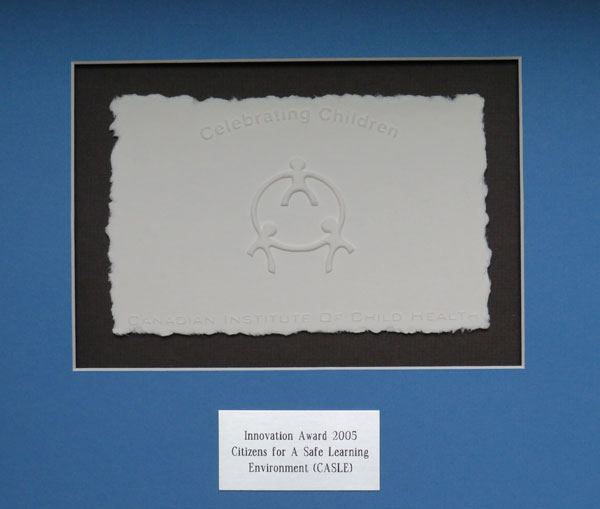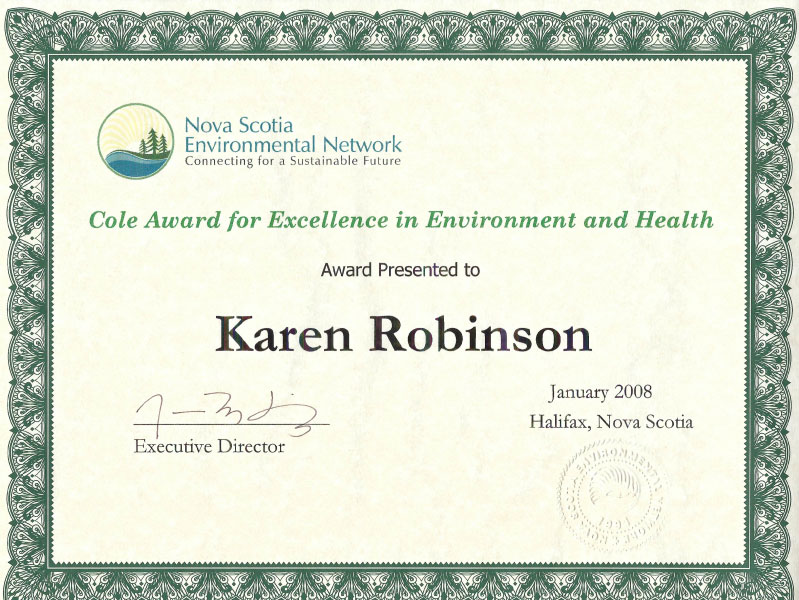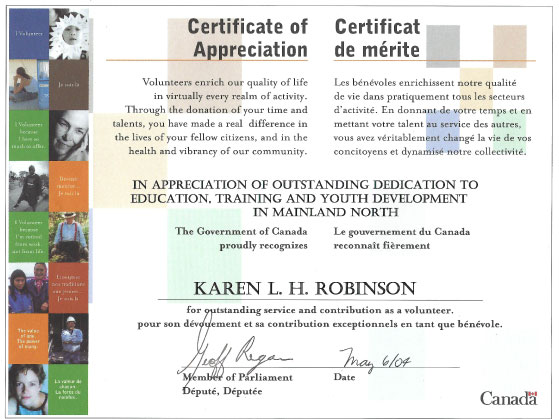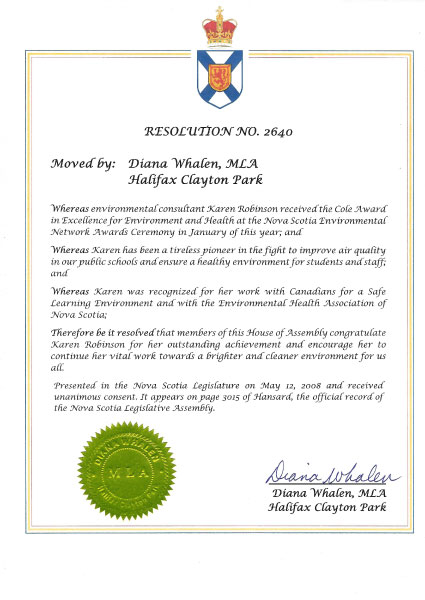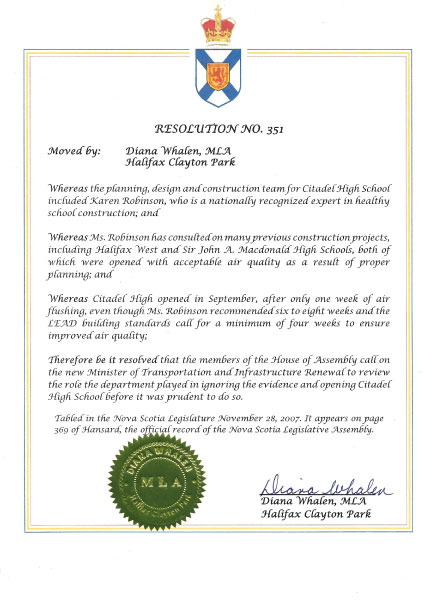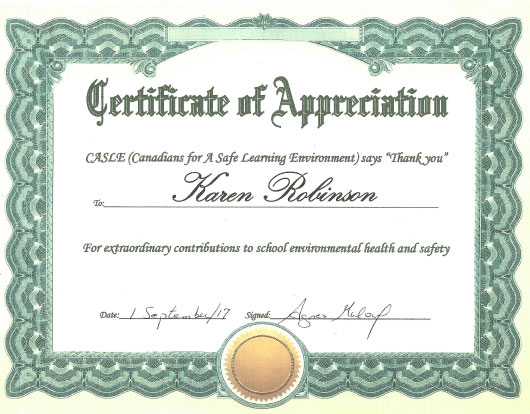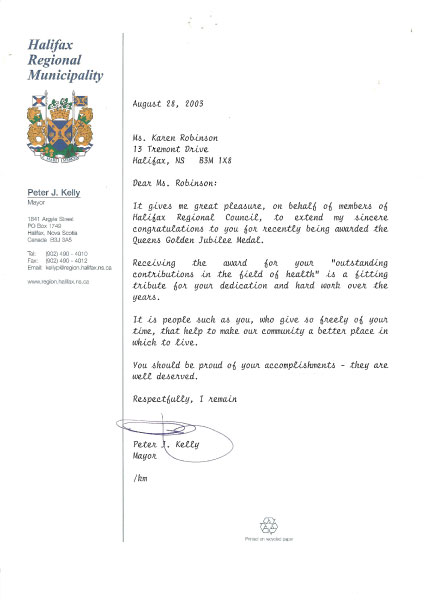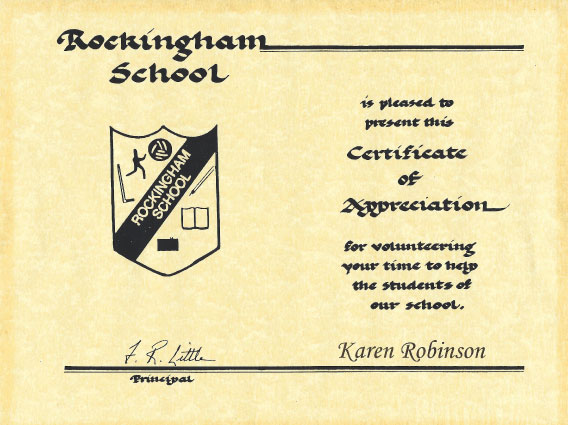What CASLE Did and Why
Our Mission
With solid information, respect, and persistence as our primary tools we can help provide environmentally healthy products and practices in schools, and healthy school buildings.
“WORKING TOGETHER FOR HEALTHY SCHOOLS”
We love our children more than anything, and they are our country’s greatest resource.Children are uniquely vulnerable to toxins and hazards in their environments. Our schools, their condition and the products and practices used within them, can influence children’s health, well-being and educational outcomes. We love our children more than anything, and they are our country’s greatest resource.
Whether you are a concerned parent or teacher, a professional designing a new school, a principal or a maintenance manager, CASLE’s website offers you over 25 years of experience and resources to help solve problems, and to show how healthy school environments benefit students and staff.
Clean air and a healthy environment are as important to learning as are a good curriculum and good teaching. Health, behavior, and learning ability can all be influenced by school environments.
With increased public interest in the environment, even more improvements are happening at all levels. CASLE’s work toward less-toxic/low-emission cleaning materials and building materials, for example, fits well with the work of other environmentalists.
About CASLE
CASLE closed its doors in 2018, but has kept this website available because much information is still relevant. CASLE worked hand in hand with the system, using the best available scientific information coupled with the Precautionary Principle.
Canadians for A Safe Learning Environment (CASLE) was a Registered Charity that worked to improve the condition of school buildings and the products and practices used in schools, so that school children and staffs have safe and healthy places to spend their days. Our main focus is Indoor Environment Quality, but we exercised our mandate more broadly if needed. CASLE worked hand in hand with the system, using the best available scientific information coupled with the Precautionary Principle. With solid information, respect, and persistence as our primary tools, CASLE educated, and assisted others to provide healthy school environments. Much has been accomplished, but there is much yet to do.
We documented school environment quality incidents, partnered with school boards and government departments to create thorough and effective changes, and assisted dozens of groups, school boards, parents and teachers to improve schools across the Province and the continent. Our website provides over 25 years of information and assistance to school board maintenance managers, teachers, parents, the media, government departments, politicians, and unions. CASLE has won several awards for the quality and results of our work.
Selected Contributions of CASLE (1992-2017):
- Educated and assisted parents, students, teachers, school boards, organizations, businesses, and governments in school indoor environmental health and safety
- Fostered inter-departmental and inter-agency cooperation, provincially and federally, through 25 years of successive governments, to coordinate and enhance many changes to school Environmental Health and Safety over the long term
- Reduced the use of toxic building materials in existing schools (e.g., low-emission paint, caulks, waxes) and increased the use of isolation techniques and timing measures for renovations and maintenance of schools (e.g., not painting or tarring roofs when children are in school)
- Facilitated the replacement of cleaning materials containing toxic ingredients (such as endocrine disrupters as a main ingredient) with safer alternatives across Nova Scotia and beyond.
- Led major changes to awareness and action to prevent health risks from indoor mould in schools.
- Fostered changes to teaching materials (e.g., less toxic art supplies)
- Facilitated reduced use of pesticides in and around schools and reduced use of CCA pressure-treated wood in playgrounds and new school construction before it was eliminated by industry
- Partnered with Dalhousie University on national studies funded by Health Canada to identify and understand the factors that facilitate or hinder the use of existing knowledge about Environmental Health and Safety issues and the implementation of existing guidelines
- Provided training/reviewing/resources for other jurisdictions/provinces (e.g. several New Brunswick Lung Association Healthy School Projects, including the Scent-Free video text and Train the Trainer for the IAQ Tools for Schools Kit)
- Facilitated no-vehicle-idling programs, Scent-free programs and tobacco-free programs in schools and other public buildings
- Reviewed Health Canada’s draft Tools for Schools Action Kit by invitation
- Received the Canadian Institute of Child Health’s National Award of Excellence (2005)
- Two of CASLE’s Board members (Hum and Robinson) received Queen’s Golden Jubilee Medals
Selected contributions of CASLE’s CEO/President, Robinson, when the board volunteer staff was reduced, particularly in the later years:
- Chaired the inter-departmental committee that produced Healthy Schools Design and Construction (2002) and that was integrated into the Nova Scotia Design Requirements Manual for the construction of all new public buildings, including schools, hospitals, and prisons. https://casle.ca/wp-content/uploads/2015/05/Healthy-School-Design-and-Construction-Robinson-7-2008.pdf
Appendix: https://casle.ca/wp-content/uploads/2015/05/Healthy-School-Design-and-Construction-Appendix-Robinson-7-2008.pdf - Produced the School Administrator’s Guide to a Healthy School, 2012. https://casle.ca/school-administrators-guide/
- Founded Healthy Schools Day in Canada – Journée des écoles saines du Canada in April 2009, and coordinated the national Day annually until 2017
- Co-authored Guidelines to Accommodate Students and Staff with Environmental Sensitivities, 2010, with Toronto’s Women’s College Hospital. Go to https://casle.ca/wp-content/uploads/2015/03/articles-Environmental-Sensitivities-a-guide-for-schools.pdf
- Spoke annually to teachers in training at the province’s universities
- Facilitated governmental formal identification of asbestos content in all Nova Scotia schools and establishment of new procedures for safe removal of asbestos in schools
- By request, provided several reports and recommendations to the Dept of Education resulting in adoption of significant changes (e.g. full ventilation systems and 100% fresh air for new public school ventilation systems. Healthy flooring selection, cleaning materials selection, effective selection and use of floor model filters, and more.)
- Served as a resource to media: CBC television and radio (e.g., Midday, Marketplace, The National), CBC Radio News, the Globe & Mail, the Wall Street Journal, the National Post, the British Broadcasting Corporation (BBC), the Australian Broadcasting Corporation (ABC), Boston Globe, David Kelly Productions (California), and local media.
- Received many awards, including The Queen’s Jubilee Medal, the 2008 EcoAward of the Nova Scotia Environmental Network for Excellence in Environment and Health, and four Commendations from the Nova Scotia Legislature (1994, 2007, 2008, 2012. “…a tireless pioneer improving air quality in our public schools” May, 2008)
For a more complete list of CASLE’s work, although it is impossible to list everything, go to https://casle.ca/a-casle-summary-2021/
Some historical documents are being posted on this website under the “CASLE Archive” tab.
The Story of CASLE: Toward Healthy Schools
A Look Back: It is 1990. Imagine this school
- The basement classrooms are damp, and have old, dirty carpets wall to wall.
- Whenever it rains, water leaks in around the old windows, providing a home for mould growth inside the walls. Buckets catch leaks in the halls.
- The windows themselves have been screwed shut for fear of vandalism.
- It is routine to replace old asbestos floor tiles by moving the class to one side of the room while the workers break up and remove tiles and glue down the new ones. Then all are moved to the other side to finish the job. (In one example, with windows screwed shut, three workers went home sick. One child’s health has never been the same.)
- There is a smell of sewer gas from the old locker room that was closed a few years ago.
- The curtains have been up for 25 years but have never been washed.
- When the sun shines it is too hot, and on cold days the children wear their coats.
- The forced air radiators have never been cleaned.
- The custodian uses petroleum mop oil to remove dust from floors.
- Floors are waxed and buffed during class time.
- The photocopier and laminator sit next to the secretary’s desk, without ventilation.
- In the washrooms, there are chemical deodorizers that contain neurotoxins.
- Cleaning materials contain endocrine disruptors, carcinogens, mutagens, sensitizers, and teratogens.
- There are visible black mould and water stains on ceiling tiles.
- Mould growth is covered by pushing the ceiling tile up out of sight with a new one. In one school we found 7 layers of black, mouldy tiles above the T-bar.
- In another a new drop-ceiling is built in a gymnasium to cover the mould. In another, new basement walls are installed inside the mouldy ones.
- Asbestos-covered pipes have exposed, worn, ratty areas.
- When asbestos is removed, workers wear suits and respirators while children sit nearby.
- Fluorescent lights are flickering and many don’t have covers.
- Many of these lights have old PCB-bearing ballasts.
- Halls and classrooms are painted with standard VOC-bearing paints when school is in session.
- Roofs are tarred and yards are paved while school is in session.
- Ground crews bring lawnmowers inside to refill the tanks to avoid burning the grass.
- The oil delivery truck leaks oil as it passes the entrance. Children run through the oil at recess.
- Combustion fumes enter the school from the furnace room.
- A schools brick façade is being repointed. Silica/cement dust encircles the school. Children cover their heads with their coats to enter or leave. Dust is over everything inside. Computers stop working well. Children play under the worker’s staging at recess and noon hour.
- When new schools open, children and staff report asthma, headaches, nose bleeds, rashes, losing consciousness, brain fog, and many other symptoms. One or two are taken to hospital in ambulance. Some have their health permanently changed.
- Gymnasium floors are refinished during the school year. Some go home and don’t return for days or longer.
- When the annual ant problem begins, the pest company sprays the perimeter of the school, and pesticide drifts in through the open windows over the children’s desks.
- Few schools have Occupational Health and Safety Committees although they are legally required for all workplaces.
This list goes on. These were normal conditions in our province’s schools. Children’s well-being and learning ability were being affected. Staff who spent their careers in these buildings were often suffering from building-related related health issues. It would be interesting to recount the cases in detail, the names and lives, and how each change was wrought, but that would require writing a book.
We who formed CASLE (Canadians for A Safe Learning Environment, earlier as Citizens for A Safe Learning Environment) soon realized we had work to do on many levels if changes were to be significant, and if they were to last any longer than our own daily vigilance. Principals, teachers, custodians, board members, maintenance managers, officials of government departments, politicians, parents, and citizens in general had to have their eyes opened as ours had been.
We found at first that, in particular, the Department of Labour’s Occupational Health and Safety Division was aware and was willing to take action with us. Regulations at the time had prevented their entry into schools without an invitation. Changes had to happen.
The province and country were reeling from the fall-out of the 1992 Westray Mining Disaster. Halifax’s Camp Hill Hospital incident was happening. It was to date the world’s largest incident of Sick Building Syndrome with over 800 staff sick and off work. There were new Labour regulations coming, a strong will among officials to prevent more harm, and CASLE’s timing was perfect. Twenty-six miners would not die in vain.
Over the years we faced many obstacles, detractors and discouragements. Those would be interesting stories for “the book”. We remained determined and always respectful, and overall buy-in progressed.
Over the years we faced many obstacles, detractors and discouragements. Those would be interesting stories for “the book”. We remained determined and always respectful, and overall buy-in progressed. A major obstacle was finding funding, and for a leading-edge effort that was not easy. That caused the second major obstacle, finding skilled people who would work as volunteers. We decided this work was too important to stop. CASLE’s working Board shifted over time as members came and moved on. Throughout, Karen Robinson remained, and in the final 14 years she and Janice Moore (treasurer) continued the hands-on work with the managing Board of Directors supporting, along with the huge number of government, agency, research and citizen supporters and partnerships.
Summary of action:
CASLE recognized there were problems in school indoor air quality and health and safety. Some were long-known and regulated issues such as asbestos, silica, fuel leaks. Others were more recently recognized issues such as toxic chemicals in everyday products, and indoor mould growth.
CASLE proceeded by documenting every incident and issue they found in schools, researching the topics, seeking specialists locally and anywhere in the world who would answer questions, help with facts and with finding better options. This was 1992,1993, 1994, before the internet made this easy. However, since researchers and experts were eager to have their work used, CASLE immediately found excellent quality information from willing experts at the end of a phone line or from letters and faxes. Lasting relationships were built.
CASLE gave talks to schools, departments, media, wrote letters, helped schools and individuals and in a most practical way, became the catalyst for positive change. Often over the years we have heard decision-makers say “You never once steered us wrong.”
Nova Scotia became a leader in Healthy Schools operation and construction in North America largely due to the collaboration between CASLE and the Nova Scotia Departments of Education, Labour/Occupational Health and Safety, Health, and Public Works.
As changes progressed, we were invited to speak at conferences, where we learned even more, built more relationships, and where researchers and engineers/architects were excited to help us. Really excited, because while they develop and test theories, we in Nova Scotia were applying that information, DOING it, making the changes and bringing the healthier options into use – products, practices and building conditions.
Pivotal events:
Much progress was made because several government departments and school boards made Indoor Environment Quality in schools a priority. Some pivotal events were:
- CASLE’s 1997 interdepartmental presentation to five provincial government department heads to discuss how school children were slipping through the cracks between the departments’ mandates. The departments and CASLE began coordinated efforts that have had far-reaching effects.
- The summer of 1997 saw the first Provincial Indoor Air Quality Conference on Schools hosted by the department of Education. CASLE’s Harland and Robinson made the keynote address to “set the tone” for the two days. CASLE introduced the US EPA Tools for Schools Kit to the Province at this event.
- CASLE’s 1998 report on the new Horton High School (NS’s submission to the CaGBC Canada’s Green Building Challenge) from an environmental health viewpoint was widely circulated by the Department of Education, and led to the Department requesting CASLE present to the Nova Scotia School Boards Association, the maintenance managers for the eight provincial school boards, the Department of Transportation and Public Works, Labour and Health Inspectors, and the construction consortiums that build new schools.
- CASLE’s Robinson (chair) and Hum served on the NS Department of Education’s Healthy Schools Construction Committee to guide the design and construction of Halifax West High School, the province’s benchmark Healthy School (2000). Healthy Schools Design and Construction guidelines and the Building Readiness Guidelines for New School Buildings were incorporated into the Province’s Design Requirements Manual DC350 for all public buildings in NS. Among many other healthy school items, new schools will have no recirculated air, operable windows, gymnasiums finished and gassed-off early, less toxic building materials, new locker design, no gas appliances, and much more.
We owe huge thanks to the many who helped us, including scientists and professionals who saw the potential in us, waived any fees (we had no money and were volunteers), and generously gave us huge amounts of information, guidance, and research. Also to the decision-makers at all levels who recognized what needed to be done, saw that this group had the capacity to collaborate, and took action.
A Look at Progress:
These are some examples of changes since CASLE started working. The complete list would be very long. CASLE played a role, sometimes major, sometimes minor, in each of these and many more improvements which happened during our tenure. Our hope now is that they continue:
- School boards’ maintenance managers are now appropriately skilled professionals such as management engineers.
- These managers meet regularly to share information and solve problems.
- All schools have trained Occupational Health and Safety Committees (JOHSC).
- Leaks and mould are taken seriously. International guidelines are followed.
- Isolation methods, Safe Work Practices, and scheduling with children’s vulnerability in mind are used for renovations and maintenance.
- For example, floor waxing is done after hours. Floor stripping is done on weekends or vacations.
- Since 1998 all new schools in NS exceed ASHRAE’s ventilation standards, including 100% fresh air ventilation. Halls are ventilated and have a new locker design.
- The Province builds its own high quality portable classrooms because previous models were affecting health and learning ability.
- Safer alternatives to pesticides are used in and around schools.
- Less toxic paints, caulks, and other safer maintenance materials are used.
- Schools use least-toxic cleaning materials.
- Chlorine bleach is used only with permission from the operations department, and only for dealing with special mould problems.
- Neurotoxin-based bathroom deodorizers are not used.
- Most schools have Scent-Smart programs and discourage use of VOC bearing products such as liquid white-out.
- Vehicle idling is reduced and controlled to prevent exhaust from entering schools.
- CCA pressure treated wood was eliminated from NS schools long before the industry made changes.
- Boards have policies on Life Threatening Allergies and Anaphylaxis (e.g., serious nut allergy) and Smoke-free/Tobacco-free policies.
- Carpets were removed from schools across the province. New schools are built mostly without.
- Schools have photocopier rooms and laminators vented – some on request, some proactively.
- Computer rooms are configured to reduce electromagnetic field exposure.
- When students or staff express that something in or about the building is making them feel ill, administrators, JOHSC and school boards take this seriously and Indoor Air Quality Protocols are used to avoid harm and to seek solutions.
- Practices are changing. For example, when roofers began tarring during school hours, one principal evacuated the school. In another school, students and staff were removed far upwind while the principal sent the workers away.
- All NS schools were audited for asbestos and have school-specific reports to guide action.
- All schools were assessed for radon and mitigation is being done.
- New schools are built to be healthy buildings the day they open and for the life of the building. That is another entire effort with its own compelling list.
- The list goes on, and that is good.
The benefits and cost savings to families, to the health care system, to insurance claims, and to the Province also bear mentioning. Long before most regions were even aware of the importance, Nova Scotia’s schools were using preventive measures to reduce health-related problems. Most schools have been repaired or upgraded, and those that can’t be fixed are replaced. When problems arise, they are noticed and fixed. Still, some of these conditions can sometimes be found in our province, and much work is needed elsewhere in Canada and the United States.
What is a Healthy School? “A school with the following attributes would support student and teacher health, learning, and productivity: a dry building with good indoor air quality and thermal comfort, that is clean, quiet, and well maintained.” (W.J. Fisk et. al., Significance of the School Physical Environment – A Commentary. June, 2016)
Because of the potential for real harm to students or staff, it is important that we remain aware of these and other hazards, continue to address them, and look for potential new hazards that might emerge as time and technologies progress.
Healthy Schools Don’t Just Happen. They Need You.
Awards
CASLE received the 2005 Health Promotion and Innovation Award of Excellence from The Canadian Institute of Child Health, Ottawa, 2005
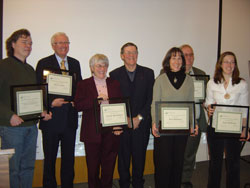
CASLE’s President, Karen Robinson, (third from right) received the 2008 Award for Excellence in Environment and Health, Eco-Awards of the Nova Scotia Environmental Network (NSEN)

Queen Elizabeth’s Golden Jubilee Medals were awarded to CASLE’s Debbie Hum and Karen Robinson, November 12, 2004. L to R: Debbie Hum, Corinne Harland, Nova Scotia’s Lieutenant Governor Myra Freeman, Karen Robinson and John Sparling
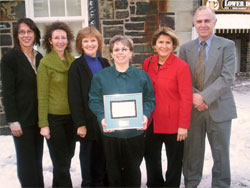
CASLE received the Health Promotion and Innovation Award of Excellence from the Canadian Institute of Child Health (CICH) at the CICH 8th annual gala dinner held in the Ottawa Congress Centre on National Child Day. (from left to right Karen Robinson, Agnes Malouf, Avis Ratchford, Sandy Moser, Elizabeth Martin, John Sparling)
The 2012 commendation document is missing and will be added at a later date
Some Work to do
- Indoor Air Quality problems can develop in any school and at any time. The challenge is to notice them and fix them well and quickly. If a school community is knowledgeable, then conditions can be spotted faster and before harm can occur to students and staff.
- The difference between “Green” schools and “Healthy” schools is slowly closing, but there is more to be done. They are complementary, but they are not the same. It is important to know how and why.
- All schools would benefit from Health Canada’s Tools for Schools IAQ Kit or a similar program.
- Parents have a positive role to play on school Joint Occupational Health and Safety Committees (JOHSC), and the NS Department of Labour supports parental/community involvement. More schools could take advantage of parent, student, and local expert input. See: https://casle.ca/wp-content/uploads/2021/05/JOHSC-parent-members-2000.pdf and https://casle.ca/wp-content/uploads/2021/05/media-release-re-Parents-on-JOHSCs2000.pdf
- See articles and links on each of these topics and more on this website.

